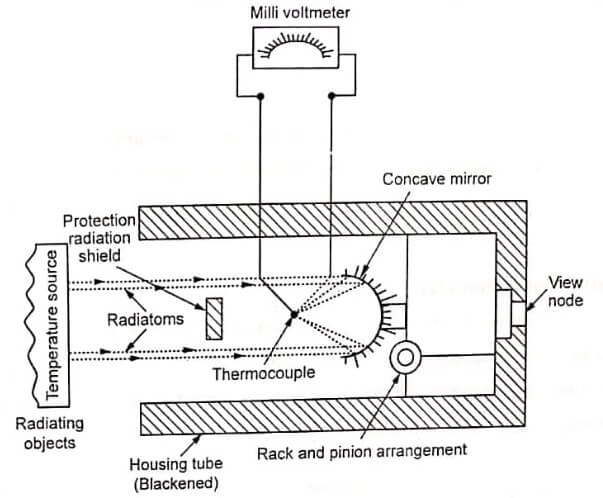Thermal radiation pyrometers is electro magnetic radiation emitted by a body as a result of its temperature. Thermal radiation is in the wavelength region from about 0.1 to 100µm. The total radiation emitted by a blackbody is given as,
Eb = σ x T4
Where,
σ ⇒ Stefan boltzman constant = 5.669 x 10-8 W/m² K
Eb ⇒ Emissive power.
T ⇒ Absolute temperature in K.
Construction:
The total radiation of pyrometer has one housing tube in which adjustable eye piece is fixed at one end of the housing tube and the other end is free to receive radiations from the radiating object whose temperature is to be measured. A rack and pinion attachment is used to adjust the position of a concave mirror.
A thermocouple is also provided to receive the radiation and the thermocouple is connected to the millivoltmeter to measure the temperature.
Working:
Thermal radiation pyrometers from the radiating object are come inside the housing tube. These radiations are fallen on the concave mirror and it is reflected to the hot junction of the thermocouple. So, an e.m.f will be produced in the thermocouple and it is measured by using a millivoltmeter. This change in e.m.f will give the measure of temperature.
Application:
It is used to measure the high temperature of 3500°C.
Advantages:
- It has high accuracy.
- No physical contact with the radiating object.
- The distance between the radiating object and the pyrometer is neglected.
Disadvantages:
- Sensitivity is poor when measuring low temperature.
- It is not suitable for very less temperature measurement.
- Dust, smoke, gases in between the radiating object and the instrument will cause error.
| Read More Topics |
| Metric system of measurement |
| Type Coordinate measuring machine (CMM) |
| Exhaust gas recirculation (EGR) |
| Errors in measurement |
| Laser Doppler Anemometer (LDA) |






